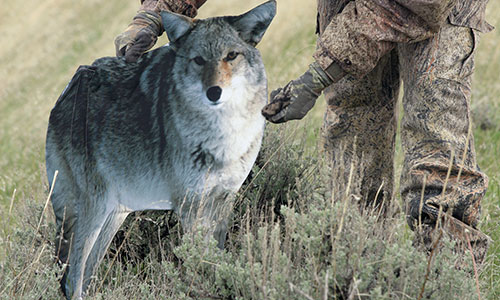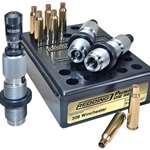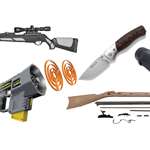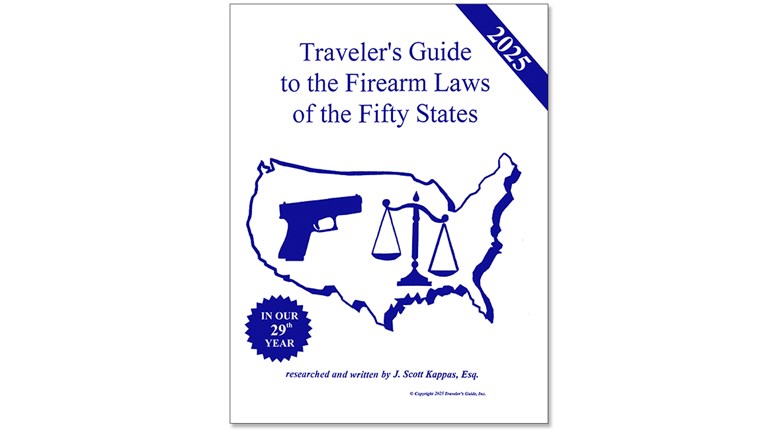Photo Courtesy of the USFWS
"It just stopped, sat down and stared in my direction from 500 yards away," I explained in disgust at the outcome of my latest coyote hunt during a call to a buddy. "I think the hunting pressure is causing coyotes to act spooky and I certainly have to boost their confidence if I want to stack some fur this year."
Competition for coyotes has increased exponentially in the past decade. Though the numbers may not be ticking up like the national debt clock, you can't argue against the evidence. A stroll through your local sporting goods store tells the tale. More new predator rifles, scopes, ammunition and predator-hunting equipment than ever before crowds shelves. It screams that companies have embraced the growing predator-hunting ranks and their dollars. Do you need more convincing?
According to the 2011 National Survey of Fishing, Hunting and Wildlife-Associated Recreation, the latest completed by the U.S. Fish and Wildlife Service, there are 2.2 million hunters who pursue game other than big game, small game and migratory waterfowl. That "other" category includes hunters who basically chase varmints and accounted for only 1.5 million hunters in 1996. Today, that growing group spends 34 million days combined annually in the field with coyotes being a top catch.
While hunters help to trim coyote densities, you can't debate their tutorial aid in educating coyotes that get away. To counter the education of this explosive hunting group you may need to boost the confidence of coyotes that have passed Hunter 101 courses with gold stars.
Coyotes are paranoid by nature, hence the cartoon character's name Wile E. Put that coyote's seemingly dim-witted persona aside. Real coyotes embrace the wily designation and learn quickly through survival. Every time a coyote survives a hunting encounter it amplifies its mistrust. To calm the fears of suspicious coyotes, you need to assure coyotes that what they hear is real, harmless and, above all, reason enough to investigate. Boost a coyote's confidence and you may boost the number of coyote passengers in your truck bed this winter.
Sounds of Solace
Whether you hunt country with a view as big as Texas or as confining as an Illinois woodlot, sounds can aid in making the setting appealing to coyotes within hearing range. Simply blaring the bawls of a wounded rabbit could lure in a coyote, especially an adolescent one, but don't count on it for a chance at a mature coyote that's been educated by a downwind alarm. Those coyotes will need more convincing, so add in the sounds coyotes find comforting.
Birds of a feather flock together, and even though coyotes don't have feathers they oftentimes have a flock in tow consisting of airborne brethren. Common crows thrive across the country. In fact, modern populations likely exceed those found before European settlement. Some roosts house a half million or more birds. These rowdy aerial omnivores are opportunistic and not shy about joining in a meal regardless of the dinner host. Coyotes may nip at crows trying to crowd the lunch counter, but on large spreads such as a dead cow, it's not uncommon to see crows picking for scraps while a coyote gorges nearby.
Crows not only home in on the same kill sites that coyotes target, but they also routinely follow or check on coyotes for an update on hunting success. As crafty scavengers, they realize that eventually coyotes will land a meal, and if there are leftovers they want to be first in line for scraps.
Always on the hunt, crows target sounds that also resonate with the sounds of a meal. Your prey-in-distress calls easily fit that definition; thus the reason crows oftentimes arrive to the site of your coyote stand. As a terra-firma-bound hunter you won't be able to determine whether incoming crows are following a coyote or simply arriving out of nosiness. In either case stay concealed. Crows and magpies have excellent eyesight and can also shout alarms that coyotes may pick up on, thus causing them to detour from the area. Stop calling, sit still and allow the inflight security system to move on, but at the same time scan for any coyotes that may be arriving.
Crows aren't the only feathered fan of coyotes, but a crow call is one of the easier calls to find in sporting goods stores and master. Ravens, black-billed magpies, jays and even songbirds trail coyotes. They also arrive at kill sites and may squawk alarms if a coyote arrives, or if they spy you. Adding in any of these bird calls can provide dual purpose to your setups. First, it can boost the confidence of a nearby coyote leery of the situation. They, too, know that birds are often the first to detect danger. Second, coyotes that hear the clatter of distant scavengers may move in that direction thinking they might be able to join a picnic in progress.
On a New Mexico coyote hunt several years back, I was stretching the limits of my lung power when I spied a trio of crows beelining in my direction. Obviously they had pinpointed my prey calls, but were they also monitoring a coyote's course below me? Before they arrived I hugged the morning shadows and eased my rifle around a juniper branch to aim in the direction of the crows. I was statuesque as they flapped overhead, but seconds later a coyote burst from a gully, trotting to within 50 yards of my position. He may have had a crow security harem, but he couldn't escape the speed of my Hornady V-Max bullet.
Another coyote confidence booster is their own language. Howls and yips tell coyotes within hearing distance that another of their kin is nearby. Barks generally broadcast an air of questioning and should be avoided in most instances. Nevertheless, howls and yips typically rankle coyotes or simply spur interest. In either case it can boost coyote conviction.
So why did I mention this sound last? As more and more predator hunters move to digital callers, it's easier than ever to add coyote language into setups. When I first started hunting coyotes in earnest, more than two decades ago, few could master the art of howling coyotes. Today it's become as common as using the rabbit-in-distress call, and in some areas I believe it creates more distrust than confidence.
I don't suggest shelving coyote vocalizations, but instead use them sparingly. A simple howl or a short series sounds normal and gives a coyote assurance that everything is okay. Too much of a good thing can create confusion and skepticism, especially if you feel other aspiring coyote hunters are howling on every section of land in the county.
Destroy Doubt with Decoys
Calls should attract curious coyotes, but like most game, they expect to see what they hear when they arrive onsite. Instead of having them ask, "Where's the beef?" show them the money. Add a decoy. If you decide to boost confidence using scavenger birds as noted previously, you can easily add crow decoys with a stop at your local hunting outlet of choice. FoxPro pro staffer Al Morris doesn't shy from the fact he began using crow decoys as a way to calm coyote fears years ago and still shares that tip today with callers who wonder why they struggle with coyote success.
I keep several crow decoys handy for employment. In open country I have one screwed to a stick that I can stuff in a snowbank, a sage clump or even lean against a fence. If there are branches nearby, I stick with a standard model and clip it on a limb in sight. If a coyote does arrive, it might be the impetus for a closer inspection. I oftentimes toss in crow caws because it's easy to attract crows, raise a commotion and possibly attract coyote attention.
Crow decoys add confidence nationwide, but if you want to add regional appeal consider decoys like the Western favorite, the black-billed magpie. E.L.K. Inc. offers one of the few magpie decoys. It includes a repeating feeding call when activated and its presence won't alarm coyotes. A magpie's calling cadence is as Western as the sight of cowboy hats in Wyoming.
Hungry coyotes will always be looking for dinner, so depending on what prey-in-peril call you use, team it with the appropriate decoy. You can find lightweight, photo-realistic decoys of fawns and rabbits like those from Montana Decoy. They deploy quickly, look real from a distance and are easy to pack. If you want a bit of jiggle in your decoy illusion, any number of motorized decoys are available including several alluring models that include both decoy and caller. The Mojo Double Trouble, Primos' Boss Dogg and Foxpro's Fusion are examples of combo callers with remote capabilities—and decoy action included.
Incorporating coyote vocalizations into your setup may call for the sight of a canine if your intended target arrives. Montana Decoy's Kojo coyote, Flambeau's Lone Howler or the Edge Expedite Yote coyote all provide realistic and economical options to con coyotes into believing the howls they heard were real. Coyote likenesses bolster coyotes with apprehensions and may even incite a fight for territory. I've put out the Kojo decoy on numerous occasions and it's been a help, not a hindrance, for enticing coyotes that may have reluctant tendencies. In recent years I added a real dog as my mainstay hunting partner. My border collie, Sage, stays by my side until needed. On most setups she never goes into action and simply watches as a bystander, but when a coyote does hang up she's eager to confront the home team and in most cases irks the coyote enough to bring it into rifle range.
Last season she and I were on a setup one snowy afternoon in Montana. Nothing answered my calls, and after 35 minutes I decided to hang it up and point my truck toward home. As I gathered my calls I let Sage roam and she darted into the canyon below to mark her own territory. Out of the corner of my eye I caught a coyote charging onto the scene. It locked up and sat down directly above Sage, giving me several seconds to rack a round in my S&W M&P15, lie prone and settle for the shot. The coyote never saw any of my fumbling as it kept its entire focus on Sage. I owe that fur payment all to the power of a decoy that occasionally smells like a dog.
Location Loyalty
Calls and decoys may be the answer to your coyote conundrum, but to ensure your elements of confidence provide the solution, set up where the coyotes want to go. Humans have a tendency to take the path of least resistance, call near the vehicle and not go the extra mile. This equals setting up in some places coyotes may deem dangerous, thus crashing your success even before you press the start button on your caller. They just won't take the trip if it doesn't feel safe.
First, try to visualize a coyote's day planner. You want to come as close as possible to determining where a coyote starts its day, where it holes up during daylight and where it starts its nocturnal roving for a midnight snack. After surmising a coyote's day, look at your hunting area from above via any number of online satellite imagery sites like the fan favorite, Google Earth. Note roads, trails, heavy cover, coyote hunting areas and all human activity zones. You're looking for areas that coyotes will avoid and where coyotes may congregate.
Start easy and inventory locations coyotes will avoid such as roads or homesteads during daylight hours. They may hunt roadside ditches for road kill under the cover of darkness or raid dog food bowls on doorsteps, but like Dracula, they'll head for coffin-like cover at sunrise. Most of America's coyotes sense hunting pressure. A few have the bullet burns as reminders. Unless you have the padlock combination to a vast Western ranch that hasn't been hunted be aware of areas coyotes will detour around once humans begin stirring at sunrise.
Once America awakens, most coyotes sulk into the shadows. Log locations that coyotes may favor such as canyons, thickets and wetlands. These spots serve as refuges where coyotes retreat when not on the hunt for their next meal and to avoid being the target of a redneck drive-by shooting.
Lastly, do your best to distinguish top coyote hunting areas where you may catch a coyote leaving or trotting toward you with a hunting focus. Meadows, hedgerows, agricultural edges, livestock concentrations and the like all scream coyote buffet. This is where coyotes will hunt for mice, partner up for bunny busting and scrounge for any misfortunate calf, lamb or piglet that fails to pass Mother Nature's version of "Survivor."
With your list in hand, plan a hunt that meets coyotes on the way out in the morning or moving toward hunting areas in the evening. This strategy means you may have to find back-door access and spend more time getting to setup sites. Be in place before shooting light and early enough before sunset to get a head start on coyotes before they launch late-day hunts.
It will pay off. If you place yourself between where a coyote has been and where it is going you'll up your odds of having one swing in to your calls. If you try to call it back toward a road or trail from where it just left, your success will sink. Think of it this way: Do you prefer to return to an area you just left as opposed to moving forward to a new destination?
One of my top coyote hunting areas overlooks a brushy creek, ideal for coyotes to snatch a cottontail during an evening hunt. It also holds a rural road that rarely sees traffic after dark. The coyotes know this and drop from the surrounding breaks and hills to hunt under cover of darkness, but at daylight they skedaddle back to the high hills for daytime sanctuary. I use a ranch road to access those hills and hike nearly a mile to quietly place myself above canyons leading from the creek to the high positions.
One morning after placing my Kojo decoy slightly below my position, I howled and then waited for about five minutes. Nothing happened so I bawled like a battered fawn and added the cawing of a flock of excited crows. My crow call was still steaming when a lone coyote galloped out of the canyon and locked on my decoy. It slowed to a walk and started to circle, perfectly sizing up the competition with bold confidence. I have to admit my confidence was also on overdrive as the coyote piled up in the snow from the slam-dunk shot.






































